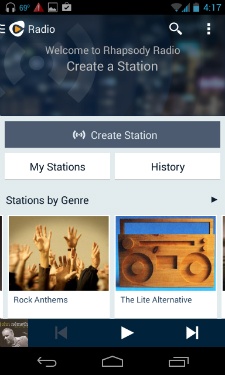 Rhapsody, one of the oldest listening platforms, a subscription-only pureplay, and lately a beleaguered business wracked with internal changes, has brought new features to its Radio product. “Radio” in this context means playlists. Until now, Rhapsody has offered a suite of house-curated genre stations, but no artist-seeded or song-seeded stations in the Spotify and Pandora style.
Rhapsody, one of the oldest listening platforms, a subscription-only pureplay, and lately a beleaguered business wracked with internal changes, has brought new features to its Radio product. “Radio” in this context means playlists. Until now, Rhapsody has offered a suite of house-curated genre stations, but no artist-seeded or song-seeded stations in the Spotify and Pandora style.
Customized radio is increasingly desired by users who like to lean in a bit, by choosing a band or single track, then lean back and enjoy a stream of songs related to the band or track. Selections are refined by whatever the service knows about the user’s taste. That interactive model usually includes thumbs-up and thumbs-down arrows, the ability to skip forward, and an option to add any track to a collection of favorites.
It’s a good model, satisfying to use, accommodating of different listening postures, and conducive to music discovery. Rhapsody is late to the game, inasmuch as Pandora, iTunes Radio, Spotify, Rdio, and Google All Access feature the same “radio”-style feature set. This week’s enhancement comes one year after Rhapsody partnered with The Echo Nest, a leading provider of music recommendation technology to listening platforms.
Rhapsody’s new product includes a feature increasingly seen in “radio” setting: a Variety slider that determines how far afield the artist station is allowed to venture from the artist characteristics. iTunes Radio has something similar. It is a calibrating feature that reflects how adventurous the user is feeling.
In our listening tests of Rhapsody’s new Radio, using an account with extensive Rhapsody history, throwing the slider to the far right (more variety) widened the scope of listening noticeably, but not radically. In a blues-rock station fashioned after Eric Gales, the greatest variety setting brought in a harder rock edge. One terrific aspect of the Variety slider is the list of five upcoming tracks. You can jump ahead to any one of them. Moving the slider refreshes the list in real time, giving you an idea of what’s in store at any variety level.
widened the scope of listening noticeably, but not radically. In a blues-rock station fashioned after Eric Gales, the greatest variety setting brought in a harder rock edge. One terrific aspect of the Variety slider is the list of five upcoming tracks. You can jump ahead to any one of them. Moving the slider refreshes the list in real time, giving you an idea of what’s in store at any variety level.
While Rhapsody’s new package is a valuable service enhancement, there is a depressing degree of conformity solidifying in this space like drying cement. Artist-based, dynamically created, radio-style playlists all seem to operate in the same way, distinguished only by small usability details. Product development is lacking innovation. Rdio recently launched its “Stations” utility, achieving product parity with Spotify. Slacker introduced “My Vibe” stations, nearly cloning Songza’s “Life Moment” listening scheme. iTunes Radio launched in an overt imitation of Pandora’s successful Internet radio model.
Everybody is reaching parity with everyone else. User choice is based on either interface design, music selection quality, or habit. Pandora is one service with a unique back end, the result of years of R&D into the characteristics of music and the signifiers of music taste. In all cases, including Pandora, quality of music selection is improved by sticking with one system and building up a history of liking, skipping, and saving tracks. In a field marked by elusive profitability, the homogeneity of interactive listening sets the stage for future consolidation.
For now, the venerable Rhapsody, which started in 2000, has joined the pack with a standard feature set for artist-based stations — it is well implemented for the most part, and sounds good.
